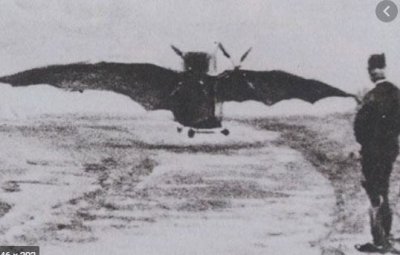- Joined
- Aug 7, 2001
- Messages
- 54,631
Was it by this chap?
(Photos on source page.)
http://news.bbc.co.uk/2/hi/uk_news/3042182.stm
The forgotten father of flight
Sir George Cayley: Unsung hero
As the 150th anniversary of the first manned flight is celebrated on Saturday, BBC News Online's Peter Gould reports on unsung hero Sir George Cayley, the "father of aviation".
Ask anyone about the history of aviation, and they will tell you exactly how it all began.
In December 1903, the Wright Brothers took their wood and fabric biplane to the sand dunes of Kitty Hawk, North Carolina.
Their historic flight - the first by a powered and manned aircraft - lasted just 12 seconds and covered no more than 120 feet (37 metres).
But it was the realisation of a centuries-old dream, and it was to change the world.
Orville and Wilbur Wright secured their place in the history books, and this year, their remarkable achievement is being celebrated at centenary events in the United States and around the world.
The Wright Brothers used Cayley's theories on their first flight
But who now remembers Sir George Cayley?
Very few in Britain, it seems, even though this remarkable inventor paved the way for the Wright Brothers and all the aviators who followed.
If it had not been for Sir George's pioneering work, the Wright brothers may not have got off the ground.
Cayley is the man described by aviation experts as the father of aeronautics.
He designed his first aircraft as long ago as 1799, and by the middle of the 19th Century, he was building and flying gliders.
Alarm
A small boy was the first passenger.
But Cayley realised that only a flight with a grown man would demonstrate the potential of his strange-looking aircraft.
So in 1853, Sir George's coachman was ordered to take to the skies at Brompton-by-Sawdon, near Scarborough.
After his alarming experience of air travel, a shocked John Appleby faced his employer.
"Please, Sir George, I wish to give notice," he said. "I was hired to drive and not to fly."
The servant may not have appreciated it, but he had just made history by completing the first manned flight in a fixed-wing aircraft.
Amazingly, the inventor whose vision made it possible has been largely forgotten in his own country.
Sir George's coachman was an unwilling pilot
"The French and the Americans take more interest in Sir George than we do," says the Reverend Leonard Rivett, a retired pastor who has spent years documenting the Cayley story.
"He laid the foundations of aeronautics in 1799 by discovering the principles of lift and thrust, and the means of vertical and horizontal control.
"The Wright Brothers knew that an Englishman had worked out the theory, and asked for his research.
"If Cayley had come across a lightweight engine, we would have had powered flight 50s years before the Wrights."
'George who?'
But back in the 19th Century, the Yorkshire inventor was way ahead of the available technology.
Powered flight would have to wait for the Wright Flyer with its simple 12-horsepower engine.
The importance of Cayley's work has been acknowledged by the US space agency Nasa, and many other scientific institutions around the world.
But when his name is mentioned in Britain, the puzzled response is usually: "George who?"
His papers are in the archives of the Royal Aeronautical Society, but few museums display his work, and it is difficult to find public recognition for his achievements.
This weekend, 150 years after Sir George's coachman was carried aloft, the aircraft will be given pride of place in celebrations intended to remind Britain about its forgotten pioneer of aviation.
'Understated'
On Saturday, an exact copy of the glider, made from modern materials, will be flown at Brompton Dale, watched by descendants of Sir George and his coachman.
And on Sunday, VIPs will gather and a band will play at the Yorkshire Air Museum, at Elvington, as replicas of Cayley's aircraft and the Wright Flyer are displayed alongside each other.
"Cayley's achievements have long been understated in Britain," says Ian Dewar, the museum's operations manager.
"My generation was brought up to believe that the Wright brothers were the fathers of aviation, but they attributed their success to his achievements.
"After their first flight, they said they owed it all to George Cayley."
This year the world salutes the Wright brothers as we mark the completion of the first 100 years of powered flight.
For us in Britain, it seems a good time to give proper recognition to the Yorkshireman who made it all possible.
(Photos on source page.)
http://news.bbc.co.uk/2/hi/uk_news/3042182.stm
Last edited by a moderator:



